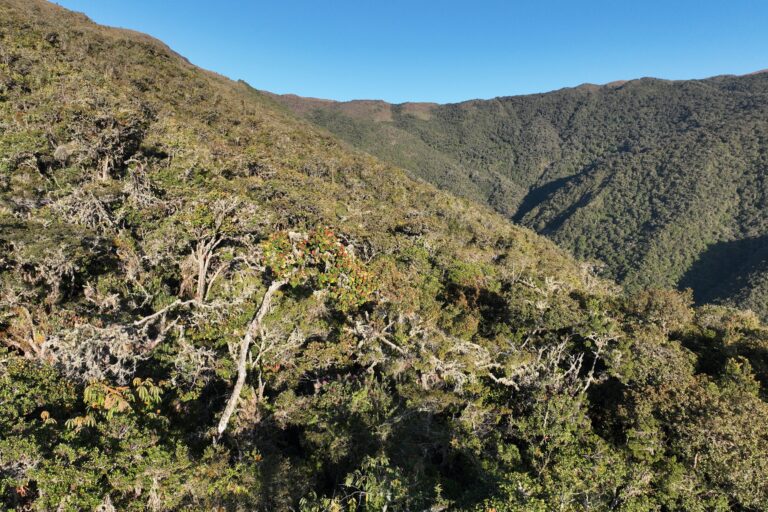- New research led by the University of Oxford could help governments better prioritize restoration and conservation interventions across the tropical Andes.
- The study evaluated how mountain forests in the region recovered over a 15-year period, identifying four possible recovery trajectories, ranging from natural to arrested.
- Andean tropical mountain forests are some of the world’s most biodiverse forests, but so far studies on how these ecosystems bounce back after disruption have been limited; researchers estimate that restoration is stalling in 73% of the area studied.
- Between 2001 and 2014, about 5 million hectares (about 12.3 million acres) of woody vegetation has been cleared in the tropical and subtropical Andes, altering mountain forests and their ecosystem services.
Degraded by human activity, mountain forests across the tropical Andes are having a hard time bouncing back. But while scientists have long analyzed what drives their decline, they have largely understudied how these ecosystems, some of the world’s most biodiverse, behave after disruption. But a better insight into forest recovery pathways could help governments in the region direct restoration efforts where they are most needed, a new study suggests.
“The Andes haven’t received the attention that a lot of the other key biodiversity hotspots have,” says Tina Christmann, environmental scientist at the School of Geography and the Environment at the University of Oxford and lead author of the study.
Exploited for centuries, mountain forests in the tropical Andes have become increasingly threatened, as deforestation for land conversion, wildfires and climate change have accelerated degradation over the last decades. According to the study, between 2001 and 2014, about 5 million hectares (about 12.3 million acres) of woody vegetation was cleared in the tropical and subtropical Andes, undermining ecosystem services and boosting carbon emissions. But during the last 20 years, land abandonment due to economic shifts and rural-to-urban migration have also created opportunities for forest regeneration.
Using high-resolution satellite imagery, researchers looked for potential restoration areas in former pastures, logging sites and agricultural lands, targeting areas where forests began to bounce back; they recorded at least a 20% increase in tree cover between 2000 and 2005. Then they analyzed how much those forests managed to recover until 2020 and saw that across the region, forest recovery overall is either disrupted, delayed or unsuccessful. “The results were startling,” Christmann told Mongabay, “with recovery stalling in 73% of the areas.”
The study looked closely at four broad types of forest recovery trajectories, established according to biodiversity levels, forest structure and level of human intervention: ongoing recovery, meaning abandoned land steadily transitions to secondary forest; disrupted recovery, where human encroachment or natural hazards interrupt that transition; arrested recovery, where factors such as invasive species can halt the growth of new forest; and no recovery, where harsh conditions or other land-use changes don’t allow trees to grow.
“We wanted to go beyond simply looking at forest loss or forest gain,” Christmann told Mongabay, moving from a binary approach of forest recovery or deforestation, to look more in depth at the ecology.
Based on the 2000-2005 data, the study found that 274 square kilometers (about 106 square miles) of land had potential for recovery. Colombia had the largest potential surface relative to its total area of national Andean forests, followed by Peru, Ecuador, Bolivia, Venezuela and Argentina. The research shows that recovery was slower throughout the following 15 years, with disrupted recovery being the most frequent trajectory in all the target countries. Further tree change analysis showed that while tree cover in potential recovery areas had gone up to 25-50% by 2005, by 2010 and 2015 much of that surface saw a new fall in tree coverage, which decreased to 10-25%.

Researchers validated the results by looking at three study cases, with different trajectories: the Intag Valley, Ecuador, where forest recovery was ongoing; Challabamba, in Cusco, Peru, dominated by disruption; and Iguaque National Park in Colombia where recovery was stalled or not possible.
As mountain forest recovery appears mostly unsuccessful, Christmann calls for better-connected, joined-up interventions for restoration in the Andes. But for these to be effective, she says, it is crucial to first identify areas where forests can recover naturally, and then put efforts into those areas where regrowth has stalled. Suitable areas need to be identified where active restoration can make a positive difference on the ground and outperform natural regeneration, she explains.
Generally, forests recover biomass and biodiversity more quickly in areas that are near remaining forest, are far from human settlements and in areas where forests haven’t been recently cleared, says the report. Conversely, forests recover more slowly, if at all, where seed dispersal is limited, the land has been heavily used and the soil and microclimate unfavorable. These are the areas that require focus, says Christmann.
Restoring these forests is difficult. Extremely cold nights, strong winds and shallow soils prevent many seeds from germinating, Christmann explains, while the lack of vegetation makes the mountains less attractive to the animals and birds that play an important role in seed dispersal, creating a vicious circle. Poor forest management also means that devastating fires are common, she adds.
The hostile landscape also means that the only way to reforest an area is by hand, using donkeys and alpacas to take seedlings up as high as 4,000 meters (more than 13,000 feet), trips that also have to be carried out in the rainy season to give the nursery-grown saplings any chance of survival. As a result, Christmann tells Mongabay, restoration work is small-scale, covering just a few hectares at a time.
The study could play an important role in creating an overall vision for forest restoration in the Andes, supporting the conservation efforts of governments and NGOs across the region.
Peru’s National Service of Natural Areas Protected by the State manages about 20 million ha (about 49.4 million acres) of land, 4% of which is considered degraded, according to Marco Arenas Aspilcueta, head of the participatory management unit. The institution has already pioneered restoration work across the tropical forests of the Peruvian Amazon and the report is influencing a new national strategy for more restoration of degraded land.

As well as helping to allocate funds toward the greatest impact, Arenas Aspilcueta says, the research will also support officials in designing better restoration strategies, helping to boost biodiversity and provide ecosystem services for local communities.
Restoration and communities
As with so many environmental projects, local people need to be involved, Christmann tells Mongabay. “What people want is to secure their agriculture, and the forest can help with that.” Restored forest can “provide so many [ecological] services that eroded land or pine forests can’t,” she says, from preventing soil erosion to boosting populations of pollinating insects.
The report’s advocacy of community involvement in forest restoration has been welcomed by the Association for the Conservation of the Amazon Basin (ACCA), an NGO that has been working to preserve Andean biodiversity in southern Peru for the last 25 years. The study, explains ACCA field coordinator Marlene Mamani Solórzano, “gives the scientific support that we require to inform the local population [and] the authorities. The results of this specific research are important to support the need and urgency of active restoration, to recover biodiversity and the services provided by these ecosystems.”
These services include improvements to local hydrology, says Solórzano, and can help to tackle the severe water shortages that provinces such as Challabamba, one of the areas that formed the basis of the study, have been suffering for the last 10 years.
The forest acts like a sponge, explains Christmann. It helps to retain water, which helps local farmers, with the improved hydrology also proving attractive to downstream water companies. By paying local communities to restore their forests, and improve an area’s hydrology, water utilities receive better-quality water, she explains. These financial incentives can then help to ensure the long-term future of restoration projects. “Once that intrinsic valuation is instilled, the desire of people to get behind it grows,” she adds.

As well as supporting montane forestry recovery in the Andes, Christmann says she believes that studying a series of high-resolution images of an area taken over a long period of time could help to locate priority regions for interventions in other highly biodiverse tropical mountain ranges and help to steer more successful restoration.
For instance, she says, in African montane forests, smallholder agriculture and clearing land for pasture use is also common. “After adapting a few parameters related to dry seasons and elevation, our methodology can help identify where and how forests grow back after land abandonment or disturbance across tropical mountain systems,” Christmann adds, “[and help] to identify local forest recovery trajectories and opportunities for active recovery.”
Citation:
Christmann, T., Palomeque, X., Armenteras, D., Wilson, S.J., Malhi, Y., & Oliveras Menor, I. (2023). Disrupted montane forest recovery hinders biodiversity conservation in the tropical Andes. Global Ecology and Biogeography, 32, 793–808. https://doi.org/10.1111/geb.13666
Banner image: Image by Rhett Butler.
FEEDBACK: Use this form to send a message to the author of this post. If you want to post a public comment, you can do that at the bottom of the page.
This story first appeared on Mongabay
South Africa Today – Environment
This article is licensed under a Creative Commons Attribution-NoDerivatives 4.0 International License.
You may republish this article, so long as you credit the authors and Mongabay, and do not change the text. Please include a link back to the original article.












